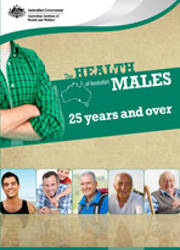Summary
This report is the fourth in a series that builds the evidence base on the health of Australia's males. This report has a focus on males aged 25 and over, who comprise two-thirds of the Australian male population and encompasses diverse life stages that see males establish themselves in the workforce, change career paths, form long-term relationships, have children and retire.
The report focuses on topics that are age-specific (such as healthy ageing), are of particular relevance to this age group (such as suicide), and those where large sex differences are observed (such as workplace injury).
Life, ageing and death
- Males aged 25 and over in 2011 can expect, on average, to live to 80 or over.
- Coronary heart disease was the leading cause of death in males aged 25 and over in 2010. Lung cancer was the second leading cause.
- Between 2001 and 2011, there was a gain of 1.9 years in life expectancy for males aged 65 and 0.6 years for males aged 85.
Risky living
- Based on measured data, in 2011-12, 44% of males aged 25 and over were overweight, 31% were obese and 66% had a waist circumference that put them at increased risk of chronic disease. The proportion of males aged 25 and over who were overweight or obese increased from 69% in 1995 to 75% in 2011-12.
- One in 10 males aged 50-59 (11%) and 60-69 (10%) are at risk of injury resulting from excessive alcohol consumption, on a daily basis.
Health status
- The prevalence rate for treated psychotic disorders is 5.8 cases per 1,000 males aged 25-64, higher than the rate among males aged 18-24 (4.0 per 1,000) and females aged 25-64 (3.7 per 1,000).
- Nearly 1 in 5 males (18%) aged 25 and over (nearly 1.3 million males) are estimated to have a core activity limitation, and need help, have difficulty with or use aids or equipment to assist with mobility, self-care or communication. More than 1 million (15%) are carers.
- Males aged 25 and over are significantly less likely to have asthma, arthritis or osteoporosis, compared with females of the same age.
Marriage, employment and health
- Married males have lower mortality rates compared with their never married counterparts-8.1 compared with 12.8 deaths per 1,000 population.
- Employed males are less likely to rate their health as fair or poor (11%) compared with unemployed males (37%) and males not in the labour force (41%).
- There were over 73,000 workers' compensation claims related to serious injury or fatality for males aged 25-64, including 170 workplace fatalities. Males in this age group made up 55% of all claims.



